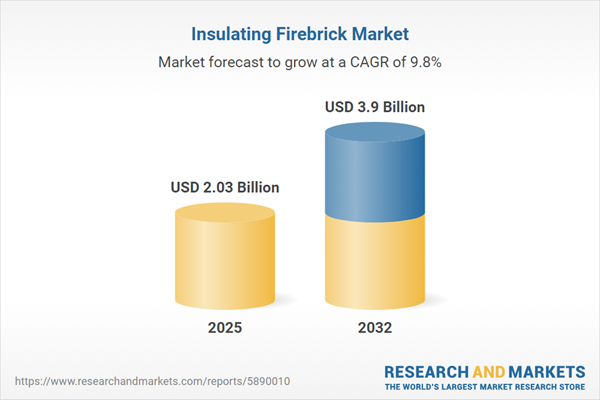Speak directly to the analyst to clarify any post sales queries you may have.
As industrial leaders seek to optimize processes in environments shaped by shifting regulations and operational demands, the insulating firebrick market is emerging as a core solution provider. These advanced refractory materials offer reliable performance, support regulatory compliance, and drive adaptability, helping businesses strengthen operational resilience and long-term value.
Market Snapshot: Insulating Firebrick Market Outlook
The insulating firebrick market is currently valued at USD 1.84 billion, set to increase to USD 2.03 billion within the next year at a compound annual growth rate of 9.78%. Long-term projections see the sector expanding to USD 3.90 billion by 2032. This sustained market momentum is fueled by industrial sectors’ continuous efforts to improve energy efficiency and enhance the reliability of thermal systems. Rising priorities include modernizing thermal system designs, revising procurement practices for optimized spend, and integrating firebrick solutions that strengthen supply chain continuity and workforce safety. Organizations in mature and emerging industries are reinforcing infrastructure and adopting these materials as foundational components of their compliance and operational strategies.
Scope & Segmentation of the Insulating Firebrick Market
- Application Areas: Solutions are used in cement kilns, glass production facilities, petrochemical plants, and the steel industry, where advanced thermal management helps organizations meet evolving safety and quality expectations across multiple manufacturing settings.
- Material Types: Alumina silicate, mullite, and silica variants accommodate varied insulation and durability demands, ensuring that firebrick options suit diverse processing conditions and complex chemical exposures.
- Product Forms: Standard blocks, insulation boards, and custom shapes ensure easy integration with both legacy equipment and new facility technologies, optimizing compatibility in plant upgrades or expansions.
- Operating Temperatures: Firebrick products perform reliably across a broad temperature range, safeguarding uninterrupted operations even within high-load and fluctuating industrial conditions.
- Distribution Channels: Availability through direct sales, specialized distributors, and digital platforms supports streamlined supply, transparency, and proactive risk mitigation throughout procurement cycles.
- Regional Coverage: This market spans North America, Europe, Asia-Pacific, the Middle East, and Africa, with product portfolios tailored to each region’s regulatory requirements, infrastructure maturity, and implementation pace of new technological processes.
- Leading Companies Analyzed: The study evaluates performance and strategies among major suppliers including RHI Magnesita, Vesuvius plc, Morgan Advanced Materials, Compagnie de Saint-Gobain, HarbisonWalker International, Calderys SA, Shinagawa Refractories, Krosaki Harima, Resco Products, and Carborundum Universal Limited, offering clear benchmarks for peer comparison and strategic planning.
Key Takeaways for Senior Decision-Makers
- Advanced refractory innovations are extending asset lifespans and reducing downtime risks, supporting stable operations under demanding industrial pressures.
- Modular firebrick deployments allow organizations to adapt quickly to site-specific demands and changes in production strategy, improving responsiveness and reducing retrofit complexity.
- Increased collaboration among suppliers, consultants, and operators is facilitating the integration of digital tools for process monitoring, simulation, and predictive maintenance, boosting operational transparency and planning accuracy.
- Sustainability initiatives, encompassing material recycling and closed-loop systems, are now integral to compliance efforts and informed environmental stewardship along the value chain.
- Diversified sourcing and agile procurement practices enhance supply chain resilience, equipping organizations to respond to variability in local and global demand dynamics.
Tariff Impact and Industry Adjustments
Recent tariffs on U.S. refractory imports are prompting operators in industries such as cement and steel to reassess their sourcing strategies. There is a clear shift toward investment in domestic manufacturing capabilities and automation to offset tariff impacts and ensure continued supply chain stability. As a result, product standards and procurement methods are being reevaluated to fortify resilience against international market shifts.
Methodology & Data Sources
This report is built on insights from executive interviews, targeted industry workshops, and structured field research. All findings have been externally validated by leading industry experts and recognized publications, ensuring conclusions that are practical, credible, and relevant for strategic decision-making.
Why This Report Matters
- Delivers targeted insights into regulatory, technology, and supply chain developments shaping the insulating firebrick market, empowering effective risk and resource management.
- Provides procurement and operations leaders with the intelligence needed to enhance decision-making and drive efficiency in energy-intensive environments.
- Enables executives to align investment and operational priorities with evolving compliance standards and best practices for improved industrial resilience.
Conclusion
Insulating firebrick remains an essential tool for managing industrial risk and optimizing operations. This report provides actionable intelligence to support effective decision-making and adaptability in a rapidly changing market environment.
Additional Product Information:
- Purchase of this report includes 1 year online access with quarterly updates.
- This report can be updated on request. Please contact our Customer Experience team using the Ask a Question widget on our website.
Table of Contents
3. Executive Summary
4. Market Overview
7. Cumulative Impact of Artificial Intelligence 2025
Companies Mentioned
The companies profiled in this Insulating Firebrick market report include:- RHI Magnesita
- Vesuvius plc
- Morgan Advanced Materials plc
- Compagnie de Saint-Gobain
- HarbisonWalker International, LLC
- Calderys SA
- Shinagawa Refractories Co., Ltd.
- Krosaki Harima Corporation
- Resco Products, Inc.
- Carborundum Universal Limited
Table Information
| Report Attribute | Details |
|---|---|
| No. of Pages | 182 |
| Published | October 2025 |
| Forecast Period | 2025 - 2032 |
| Estimated Market Value ( USD | $ 2.03 Billion |
| Forecasted Market Value ( USD | $ 3.9 Billion |
| Compound Annual Growth Rate | 9.7% |
| Regions Covered | Global |
| No. of Companies Mentioned | 11 |








